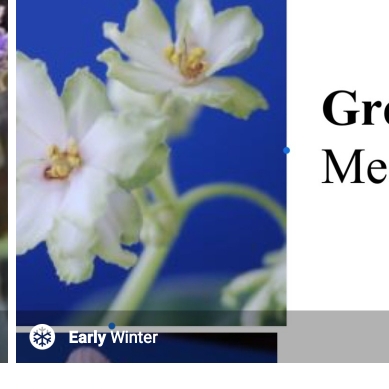
Streptocarpus sect. Saintpaulia 'Green Lace' syn. Saintpaulia 'Green Lace'
African Violet 'Green Lace'
African Violets have round to oval leaves that are finely hairy and slightly fleshy, usually dark green. The flowers grow in clusters, and have five-lobed velvety petals. They are often grown a houseplants, but can also be grown outdoors. They were recently reclassified from the latin name Saintpaulia to Streptocarpus sect. Saintpaulia. It is native to Eastern and South Western Tanzania. 'Green Lace' has white (or sometimes pink) flowers edged with a green margin and standard dark green foliage.
Contributed by @rosegardengirl
-
Partial shade
-
Very little water
-
Not Frost hardy
-
Light and free draining
Common name
African Violet 'Green Lace'
Latin name
Streptocarpus sect. Saintpaulia 'Green Lace' syn. Saintpaulia 'Green Lace'
type
Houseplant
family
Gesneriaceae
ph
5.8 - 6.2 Acid - Neutral
Plant & bloom calendar
-
Best time to plant
full grown dimensions
 0.20 M
0.10 M
0.20 M
0.10 M
Streptocarpus sect. Saintpaulia 'Green Lace' syn. Saintpaulia 'Green Lace'
African Violets have round to oval leaves that are finely hairy and slightly fleshy, usually dark green. The flowers grow in clusters, and have five-lobed velvety petals. They are often grown a houseplants, but can also be grown outdoors. They were recently reclassified from the latin name Saintpaulia to Streptocarpus sect. Saintpaulia. It is native to Eastern and South Western Tanzania. 'Green Lace' has white (or sometimes pink) flowers edged with a green margin and standard dark green foliage.
Potting African Violets
From Early Spring TO Early Spring
The soil for growing African violets must be porous to allow surplus water to pass through readily. Most violets are now grown in pasteurised soilless mixes. A good soilless mix is made up of 3 parts sphagnum peat moss, 2 parts vermiculite and 1 part perlite, with some lime added to balance the acidity of the peat moss. A good growing medium should contain 50 percent medium, 25 percent air and 25 percent water. When potting African violets, take care to set the plant so that the crown is just above the surface and the soil is firmly pressed around it. Emphasis should be on good soil drainage because free water on the surface may cause decay at the crown or at the bases of the leaf stalks. African violets adjust well to the warm temperatures and dry air of homes.
Propagation by cuttings
From Early Spring TO Early Summer
Cut off a leaf with a sharp and clean knife. The African Violet cutting can be planted in a regular potting soil or a mix between humus and sand (3:1). The ending of the leave should sit on the ground. Put it on a bright but not sunny place with a temperature > 20 °C (68 °F). Keep the soil moist but not wet. A fertiliser must not be given. There is also no need to increase humidity. After 6 to 8 weeks the African Violet cuttings will show first new leaves. After about 6 months they can be treated like the mother plant.








